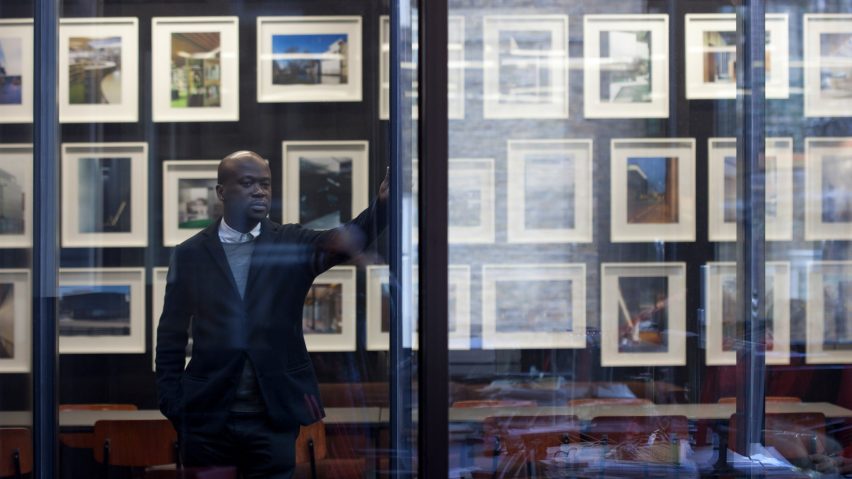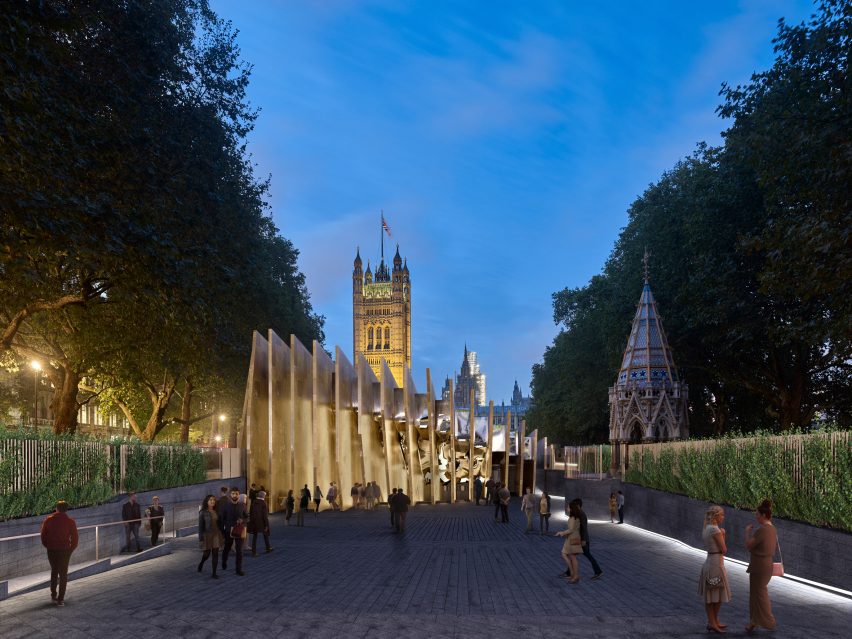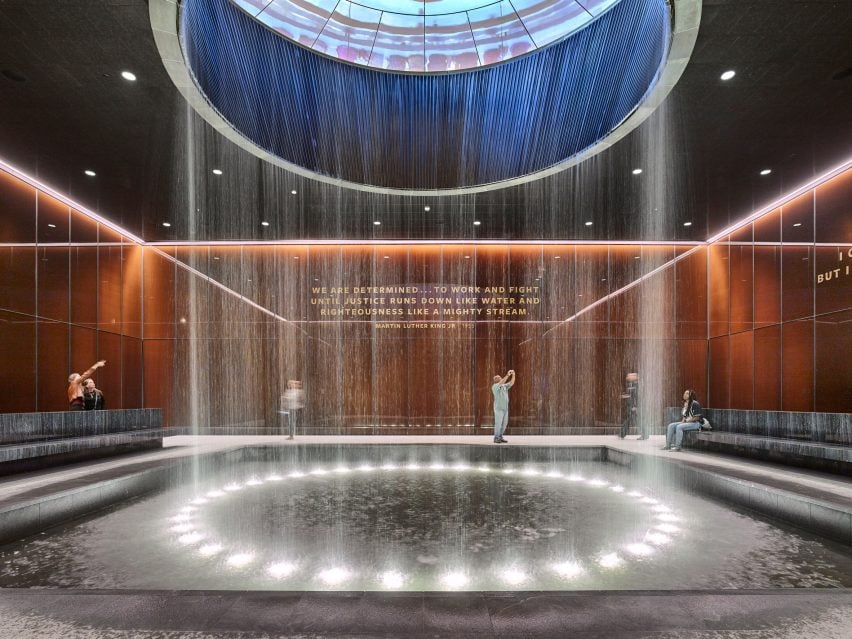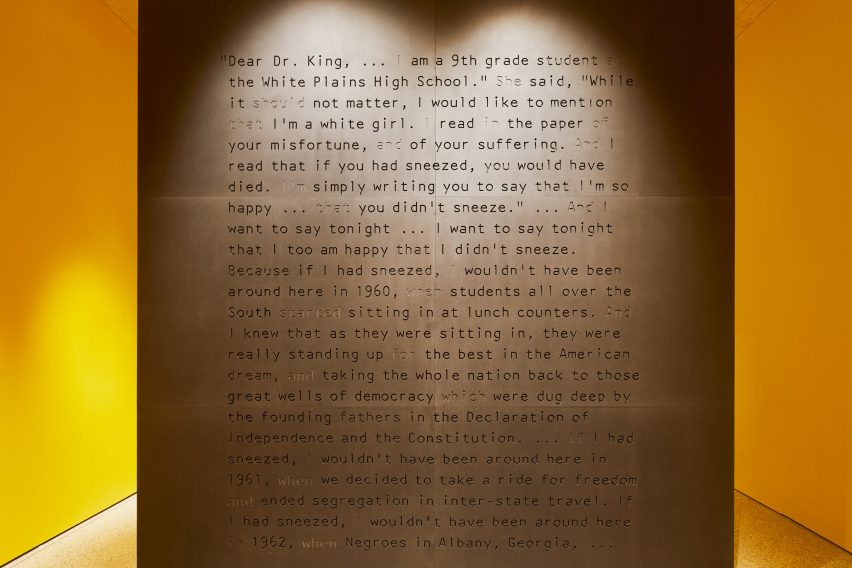
Architecture can combat fake news, says David Adjaye
David Adjaye says museums, monuments and memorials should be sites of resistance against those "propagating fictions" about climate change, civil rights or the holocaust.
Speaking to Dezeen at the launch of his exhibition Making Memory at London's Design Museum last week, the British-Ghanaian architect said architects need to work to counter false narratives that could be spread by politicians.
"I think it's important for architecture to be one of the devices that's not about propagating fictions about history and how history is written," he said.
"When your monuments contradict the narratives that have been projected, it breaks the illusion."
Holocaust memorial can stop people denying history
Adjaye's design for the UK Holocaust Museum in London, which is currently at the planning stage, has caused controversy. In particular, opponents have objected to its location next to the Palace of Westminster.
Designed in collaboration with Ron Arad Associates, the museum proposal features 23 bronze fins marking the entrance to a space sunken into Victoria Tower Gardens.

A poll released days before the interview for Holocaust Memorial Day on 27 January revealed the shocking statistic that five per cent of British adults do not believe the Holocaust took place. Adjaye said he was shocked by this news.
"I think it's such an appropriate site next to parliament. I'm not interested in anybody emerging into power and denying the past," he said.
"This monument forces that conversation to not be possible, at least around the edifice of Parliament. I don't want somebody to be able to stand in front of parliament and deny certain truths."
Smithsonian needed to counter rising white nationalism
In 2016 Adjaye Associates completed the Smithsonian National Museum of African American History and Culture, a museum in Washington DC that takes visitors on a journey through the history of the Black experience in the USA, from Africa to slavery through to emancipation and the civil-rights movement.
It's a project that he believes was long overdue in a country where white nationalism is seeing an alarming resurgence.
"It's great that I built the Smithsonian," Adjaye said. "But actually, it's kind of crazy that it's taken this long to build a narrative to a very obvious story that's really very profoundly infected this entire country."

Adjaye has plans to build the Coretta Scott King and Martin Luther King Jr Memorial in Boston, and has put a prototype on display at the Making Memory exhibition.
Its surfaces are engraved in words from the civil rights' leaders speeches realised in a custom font, by African America artist Adam Pendleton and type designer David Reinfurt, that re-animates their speech patterns.
The anthropocene will define "the work of future architects"
Climate change and the dawn of the anthropocene, the dawning geological age of mankind's adverse impact on the planet change, is another oft-denied truth Adjaye wants to confront with his architecture.
His concept for the Mass Extinction Memorial Observatory, a spiralling walkway lined with carvings of 860 extinct animals around a three-metre inverted bell that would toll each time another species was wiped out, is the one Adjaye is "most sad" hasn't been realised, yet.
"I now have children. My kids love the natural world and we talk about these things, and they can't even understand what I mean," he said.
He believes that recording what has been lost, or what humanity has destroyed, is a vital part of the conversation on conservation and climate change.
"The anthropocene is a kind of moment where we're shifting again, and you know that that has its own ramifications that we're going to be negotiating. That's the work of future architects."

Adjaye is concerned by the lack of engagement with all of these issues by architects enthralled by "hyper capitalism" who are building "glistening towers [to] represent our power and our financial might."
"We should ask architects this all the time. Yes, apart from the brief, well done, tick, what's your position on the other stuff? What about the planet? What about society?" he said.
"I'm not saying that architecture solves these problems. But architecture makes the representation of the world that allows people to kind of understand and measure things against things."
Engage with issues facing humanity or become "a slave to the machine"
Architecture should enshrine the kind of world we want, he argues, or "it allows people to believe that the world is a certain way."
Architects should serve the people of the places they build in – and the planet – just as much as their client, he believes.
"Almost every great piece of architecture I know contradicts the brief, but also enhances the brief at the same time," he said. "If you're a very talented architects, you can do both. If you're not, you're just a slave to the machine."
Making Memory is at the Design Museum in London 2 February to 5 May 2019.
Read the full interview transcript below:
India Block: What is the thread of the narrative arc you have drawn out with your Making Memory Exhibition?
David Adjaye: That thread is this idea of working in the public realm, maybe at the scale of the ordinary, or sometimes at the scale of the national or the international, and creating projects which have in-built in them a way of recording our time in some way. And building that into form.
India Block: Do you think that this is perhaps a more pressing concern, given the time we live in. You're working on the UK Holocaust Memorial at a time when Holocaust deniers out in force, people are self-identifying as Nazis. Or the Washington museum, at a time when a black man had a noose tied around his neck.
David Adjaye: Correct.
India Block: Even though we have so many more ways of recording history and verifying it, people seem to be forgetting it.
David Adjaye: They do, they do. And I think that that's actually a symptom. What we're seeing now is a symptom of the lack of response for the last half century in terms of engaging with the issues that have been evolving since the civil rights [movement] in America.
I think that architecture has, during that time, been obsessed with capitalism. And that the social and civic, which is a very important part of the role of how architecture is kind of steward, has been ignored.
I'm not saying that architecture solves these problems. But architecture makes the representation of the world that allows people to kind of understand and measure things against things. I think it's really important that that the representation of the kind of world that we want, there's also a built-in form. And when there's a lack of that, I think it allows people to believe that the world is a certain way. And I think that that's what we're in.
I mean, it's great that I built the Smithsonian. But actually, it's kind of crazy that it's taken this long to build a narrative to a very obvious story that's really very profoundly infected this entire country. But nobody actually really even knew the narrative.
I have people who are very smart going into that museum going "bloody hell, I didn't know". And before building that museum, I was being criticised that it was so obvious, this story, and it was clearly documented in the Smithsonian. And it wasn't, and it's a clear story.
Likewise with the Holocaust and the conversations were having in this country about it, which is shocking to me, but very important that these things are brought out into the public. It's very important that we actually start to make things that also shift this thing from just being something that's a discussion in pubs or whatever, into being national discussions.
When we force our leaders and force generations later, who maybe forget the kind of narratives of the time to have to confront structures or to stand in front of structures to then say, certain things, it it pricks, it does prick, it does break.
When your monuments contradict the narratives that have been projected, it breaks the illusion. I think it's important to use architecture to be also one of the devices that's not about propagating fictions about history and how history is written. If we're gonna get heavy about it [laughs]. You went there with the deep questions!
India Block: I did go in deep! So, if you could build like any monument that could address an issue today, what would you build?
David Adjaye: Gosh, I think I'm sort of working through them. Species extinction was something I started 10 years ago talking about, that there should be structures that talk about species extinction. It's one of the projects that is still in discussion, but it's not built. And it's one of the projects I'm most sad about, that it hasn't been realised.
Because I now have children. I talk to my kids about it. My kids love the natural world and we talk about these things, and they can't even understand what I mean, I'll just try to bring those issues in. And it's really interesting that there isn't a space to talk about the things that have gone, actually. That's ridiculous.
You couldn't actually start talking about how the kind of planet has evolved and the things that have naturally been lost, and also the things that man has contributed to destroying, so that we can understand where we're going. We want to talk about conservation, but we don't actually acknowledge what the reality of the past is.
India Block: Are you interested in the Anthropocene?
David Adjaye: Totally, yeah. The Anthropocene is a kind of moment where we're shifting again, and you know that that has its own ramifications that we're going to be negotiating. That's the work of future architects. I'm at the edge of that, but the building blocks of that are being built right now around us. So that's a very different narrative coming.
India Block: But not for you?
David Adjaye: Well, I'll touch it, but I think it's the generations coming behind that probably more likely to deal with that.
India Block: Do you think the MEMO will happen?
David Adjaye: I really hope that the MEMO would happen at some point, yeah. I think it's a structure whose time has come and really would be very helpful for people and understanding.
The thing about what I call the ritual of space is that you're able to use space to make a way for people to understand narratives in history in a way that's different to just reading it.
The experience of going to a museum and seeing collections imparts a certain kind of knowledge into your mind in a very different way. And I and I think it's a very powerful, haptic way of absorbing information that beds in differently and I believe that you can do that with a lot of things, not just sort of art and artefacts, etc. You can do it with science, you can do it with built environment, you can do it with so many things.
India Block: And how's everything going with the UK Holocaust Memorial? What stage are you at now?
David Adjaye: It's going well. It's a very controversial project. But we're in planning, it's a very tough discussion.
India Block: Which are the bits that are causing controversy?
David Adjaye: The whole thing. There's no bit, it's just the idea! I think, the controversy is boiling down to the site, which is the one thing we were not given a choice on.
I find it interesting that there's a conversation about the appropriateness of the site. I think it's such an appropriate site next to Parliament, because I think we live in an age where I'm just not interested in anybody emerging into power and denying the past in a way like that.
I think this monument just forces that conversation to not be possible, at least around the edifice of Parliament, which is the symbol of a kind of liberty. I just don't want somebody standing there one day – we can see how easy it is for power to slip very, very, right, or very, very left – to be able to stand in front of Parliament and deny certain truths.
That's what I mean by this creation of structures that kind of counter the fiction of a certain narrative. I think architecture has been very much in service of Empire, and images of history or fictions of history, rather than the reality of the complexity of history simply because it was a structureless world, people were just trying to make themselves last forever.
India Block: How can architects free themselves from that, if you've got somebody saying, "I want to commission a building – make be immortal, make me look amazing for the rest of time?"
David Adjaye: If you're a very talented architects, you can do both. If you're not, you're just be as the slave to the machine. Almost every great piece of architecture I know contradicts the brief, but also enhances the brief at the same time, they sort of do what you need, but also take you somewhere else. And I love that. That's the inspiring thing for me.
As an architect you serve a client who's your commissioner, but you are responsible to a patron who is your public, the public world. Because we we have this responsibility to this two-pronged thing – the person that's commissioning but to the patronage of the idea of the city and the people who use a city.
That is not a paid transaction, but it's a kind of earned transaction that it means that the contradiction in making a project for somebody is always complicated than just the barter or the payment. And I think if you just think it's about the barter or the payment, where you've lost the whole magic of what architecture is.
I think architecture is one of those art forms – and that's why it's deeply fascinating to me – that is about this binary coming together, that not only are you building a house or something, but you're building a house on the planet, and you're building a house that's about a narrative about where we are now, and what that means in the future. What is your position on that?
I would say we should ask architects this all the time. Yes, apart from the brief, well done, tick, what's your position on the other stuff?
India Block: Is that what you mean by architecture being in service to capitalism?
David Adjaye: Yes, yes, it became completely driven by the function of hyper capitalism, both in culture, you know, the sort of ever more fantastical object just because, or ever more glistening towers because that means that we can, you know, represent our power and our financial might.
Well, what about the planet? What about society? That the other questions are not being answered, and I think that you can argue that the architecture of the past was also in service to Imperial powers, mostly. But there was also a kind of sense – because of the kind of lack of technology that was to do with the kind of resource of means, which kind of checked it.
But I think post the industrialised age we are able to kind of manipulate and use resources in an unprecedented way. And, and, and we're able to manipulate form in an unprecedented way. So we have to have questions that we need to be able to ask to be able to allow us to use them, rather than just saying it's just there to be done. I find that if architecture ends up just being about that, then I think it's a really sad.